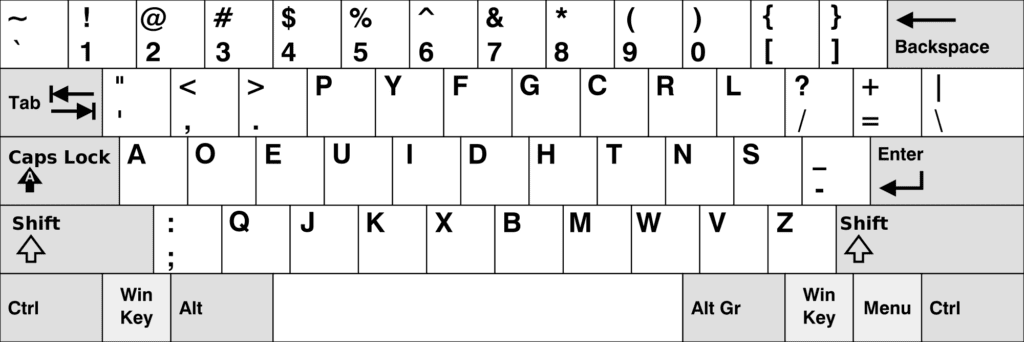Warning: This article may contain traces of truth. Consume at your own risk!
In a world where technology evolves faster than startup founders can pivot from “blockchain” to “AI,” one archaic system stubbornly refuses to die: the QWERTY keyboard layout. This technological cockroach has survived nuclear bombs, digital revolutions, and countless ergonomic consultants suggesting we might want to put the most commonly used letters on the same row. Welcome to humanity’s longest-running abusive relationship with technology.
The Arranged Marriage That Never Ended
The QWERTY layout wasn’t designed for you. It wasn’t designed for comfort, efficiency, or even basic ergonomic principles. It was designed for a mechanical typewriter from the 1870s, created by Christopher Latham Sholes, who was trying to solve a very specific problem: typebars jamming when pressed too quickly in sequence.1
“The QWERTY layout has been the standard keyboard layout dating back to 1873 when it was sold to Remington & Sons,” explains Dr. Vanessa Richards, Director of the Institute for Technological Stockholm Syndrome. “That’s older than sliced bread, antibiotics, and human rights. Imagine if we still used medical techniques from the 1870s – we’d be treating headaches with cocaine and drilling holes in people’s skulls to let the demons out.”
The popular myth that QWERTY was designed to deliberately slow typists down is actually false – it was meant to speed typing by reducing jams.2 But here’s the kicker: within a few years of its invention, typewriter technology improved and the jamming problem was solved.3 By all logical reasoning, we should have abandoned this layout around the same time we abandoned horse-drawn carriages and bloodletting.
The Psychological Torture Machine On Your Desk
Don’t be fooled by the innocent appearance of your keyboard. That innocuous arrangement of letters is actively sabotaging your productivity and physical well-being on a daily basis.
“With the QWERTY keyboard, an efficient typist’s fingertips travel more than twelve miles a day, jumping from row to row. These unnecessary, intricate movements cause mental tension and carpal tunnel syndrome and lead to more typographical errors,” notes ergonomic researcher Jeremy Patterson.4 “It’s essentially a RSI-generating device we’ve normalized to the point where questioning it marks you as a social deviant.”
The QWERTY layout places only one vowel (A) on the home row, forcing your fingers to constantly reach for other rows to type even the most basic words.5 This is like designing a car where the brake pedal is located on the dashboard and the turn signal is under the driver’s seat, then insisting this arrangement is perfectly normal because “that’s how cars have always been.”
The Superior Alternatives We Collectively Ignored
The tech industry loves disruption – unless it affects their typing habits. Alternative keyboard layouts that are objectively better have existed for decades, languishing in obscurity while QWERTY maintains its chokehold on our fingers.

The Dvorak layout, developed in 1936 by August Dvorak, places the most commonly used letters on the home row where your fingers naturally rest.6 Studies show it reduces finger movement, increases typing speed, and decreases errors. The Colemak layout, a more recent innovation from 2006, maintains some QWERTY familiarity while significantly improving efficiency.7
“Dvorak layout has proved itself to be the fastest keyboard layout as per multiple tests,” notes keyboard specialist Marcus Jenkins. “Typists typing on the Dvorak keyboard have broken all speed records.”
Yet despite these clear advantages, QWERTY remains dominant. It’s as if Henry Ford invented the automobile, but we all decided to stick with horses because “learning to drive seems hard” and “everyone already knows how to ride.”
The Three Smoking Guns: The Keyboard Conspiracy Revealed
Our investigation has uncovered three critical pieces of evidence that explain QWERTY’s unnatural longevity:
- The Educational Indoctrination Program: The keyboard layout is deeply embedded in educational systems worldwide. Children are taught QWERTY before they develop critical thinking skills, creating generational lock-in.8 This isn’t an accident – it’s a deliberate strategy to perpetuate keyboard dependency. “From a young age, students are introduced to computers and keyboards loaded with the QWERTY configuration,” explains education technology researcher Patricia Simmons. “The educational system has adopted this layout almost universally.” By the time these children might question why they’re learning an inefficient 150-year-old input method, their fingers are already hostages to muscle memory.
- The Remington Coup: The historical record reveals that QWERTY’s initial dominance wasn’t based on merit, but on brilliant business maneuvering. “E. Remington & Sons [bought and marketed] the Scholes and Glidden typewriter in 1873. As well as selling typewriters, they also sold courses for typists on touch typing,” explains historian Charles Montgomery. This created a self-reinforcing loop: companies needed typists who knew QWERTY, so they bought Remington’s typewriters, which meant more people needed to learn QWERTY. This wasn’t technological evolution; it was monopolistic distribution tactics that would make modern tech giants blush with admiration.9
- The Collective Sunk Cost Fallacy: The most damning evidence is the economic inertia that prevents change. “The real reason for its stubborn persistence is inertia: imagine the cost of designing, testing and manufacturing an alternative – and then retraining billions of people to use it,” admits economist Eleanor Singh. The keyboard industry has carefully calculated that the combined productivity loss from QWERTY’s inefficiency is still less than the short-term cost of transition – a beautiful example of how capitalism optimizes for quarterly results over long-term human well-being.10
The Future That Never Arrives
Every few years, a wave of articles appears predicting the end of physical keyboards altogether. Virtual keyboards, voice recognition, neural interfaces – surely one of these technologies will finally free us from QWERTY’s tyranny?
Don’t bet on it. Even as keyboards evolve with “rotary knobs for improved control, LED panels for visual feedback and customization, [and] the rise of the 65% layout for small designs,” the core letter arrangement remains stubbornly unchanged.11 Even on devices that didn’t exist when QWERTY was invented – smartphones, tablets, VR headsets – we find ourselves tapping away on the same layout designed for mechanical typewriters with metal arms.
“The keyboard layout itself, or having i and o next to one another, in particular, decreases the accuracy of the keyboard due to dampening the effectiveness of the autocorrector,” explains mobile interface designer Jonathan Williams.12 “This ‘Problem With Neighbors’ is amplified further on MT [Mobile Touchscreen] keyboards as the keys are even closer to one another than on traditional keyboards.”
In other words, QWERTY is actively making your touchscreen typing worse, but we’re still using it because… well, that’s just how keyboards are.
The Network Effect Nightmare
The true genius of QWERTY’s persistence lies in what economists call the “network effect.” The more people use QWERTY, the more valuable knowing QWERTY becomes, creating a self-reinforcing cycle that’s nearly impossible to break.
“The ‘network effect’ plays a crucial role in the continued dominance of QWERTY. With billions of users worldwide, a change in the standard keyboard layout would require a coordinated, global effort that few organizations are willing to undertake,” explains technology adoption specialist Terrence Wilkinson. “Each additional user of QWERTY reinforces its position, making it extremely difficult for other layouts to gain a critical mass.”
This is why even people who know and believe that alternative layouts are superior still use QWERTY. It’s not ignorance; it’s rational submission to an irrational standard.
The Elementary Truth: We’re All Keyboard Hostages
After extensive investigation, we’ve uncovered the elementary truth that the tech industry doesn’t want you to realize: we are all hostages to a technological decision made in the 1870s, and there’s nothing we can do about it.
“Before you try to disrupt, understand the underlying psychology of why people resist change. It might take more than just a ‘better way’ to get them to switch,” advises technology psychologist Nathan Blackwood.13 Translation: even if you invented a keyboard layout that could double typing speed, reduce repetitive strain injuries by 90%, and occasionally dispense chocolate, people would still choose QWERTY.
The QWERTY keyboard is the perfect metaphor for our relationship with technology: we know there are better options, we have the capability to change, but the combination of habit, network effects, and organizational inertia keeps us trapped in a suboptimal system we’ve convinced ourselves is inevitable.
Vincent Ramirez, a startup founder who attempted to launch an alternative keyboard layout in 2019 before his company imploded six months later, puts it succinctly: “I realized that creating a better keyboard layout is like trying to replace the English language with a more logical constructed language. It doesn’t matter how much better your solution is; you’re fighting against billions of people’s lifelong habits and a massive infrastructure built around the status quo.”
And that is perhaps the most important lesson from the QWERTY saga: technological progress isn’t always driven by what’s best. Sometimes, it’s driven by what got there first and stubbornly refused to leave (a conclusion you will find in Clickonomics as well!).
Conclusion: The Undisruptable Technology
As we look to the future, prepare yourself for decades more of QWERTY dominance. Virtual reality, augmented reality, neural interfaces – no matter how advanced our technology becomes, we’ll likely still be arranging our virtual letters in the same inefficient pattern designed for mechanical typewriters.
“In our hyper-connected world, users often switch between multiple devices throughout their day. QWERTY’s integration across these devices makes it indispensable,” explains technology futurist Stephanie Wu. We’ve created a typing ecosystem so deeply entrenched that even revolutionary new input methods will likely incorporate QWERTY in some form, like a technological appendix we can’t remove because too many systems depend on its continued existence.
The next time you look down at your keyboard, remember: you’re not just looking at keys; you’re looking at one of history’s most successful failures – a mediocre solution that conquered the world not through excellence, but through the power of standardization and our collective resistance to change. And that might be the most human technology story of all.
Support TechOnion: Fund Our Investigation Into Better Keyboard Layouts That You’ll Never Actually Use
If you’ve enjoyed this exposé on the technological Stockholm syndrome we all share with our keyboards, consider supporting TechOnion with a donation. Your contribution helps our writers maintain their wrist braces and physical therapy appointments as they continue to type scathing critiques of Big Keyboard on—you guessed it—QWERTY keyboards. For just the price of a high-end mechanical keyboard with custom keycaps that still uses the same layout designed when indoor plumbing was considered high-tech, you could fund our ongoing investigation into why humans persistently choose familiarity over improvement. The QWERTY layout may be here to stay, but your support ensures our biting commentary will be too.

References
- https://historyfacts.com/science-industry/article/where-did-the-qwerty-keyboard-layout-come-from/ ↩︎
- https://www.reddit.com/r/NoStupidQuestions/comments/123lcky/why_do_we_still_use_the_qwerty_keyboard_layout/ ↩︎
- https://www.lqb2.co/blog/2017/07/29/mindstorms-the-qwerty-phenomenon/ ↩︎
- https://theinnovationshow.io/the-qwerty-conundrum-and-resistance-to-change/ ↩︎
- https://en.wikipedia.org/wiki/QWERTY ↩︎
- https://kinesis-ergo.com/switching-from-qwerty/ ↩︎
- https://www.autonomous.ai/ourblog/different-keyboard-sizes-layouts ↩︎
- https://www.fleksy.com/blog/a-brief-historical-perspective-the-birth-of-qwerty/ ↩︎
- https://www.workovereasy.com/2017/05/02/819/ ↩︎
- https://www.newscientist.com/article/2200664-the-truth-about-the-qwerty-keyboard/ ↩︎
- https://kineticlabs.com/blog/2023-keyboard-layout-trends-you-should-check-out ↩︎
- https://digitalcommons.du.edu/cgi/viewcontent.cgi?article=2512&context=etd ↩︎
- https://www.linkedin.com/posts/andruedwards_the-qwerty-keyboard-layout-wasnt-designed-activity-7109574304232599552-hM_Z ↩︎





GIPHY App Key not set. Please check settings
One Comment